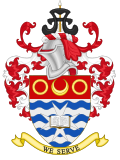Governance
Finsbury division
The liberty formed part of Ossulstone Hundred, one of six divisions of Middlesex primarily used for taxation assessment purposes after the mid medieval period as the powers of the King's courts and each parish vestry superseded those of manorial courts and especially the Hundred Court. [10] Ossulstone was the hundred nearest the city, and saw great population growth. By the 17th century the hundred divided and further empowered into divisions, and Glasshouse Yard became part of the Finsbury Division. [11]
Poor law
The liberty was a separate jurisdiction from the remainder of the parish of St Botolph for the administration of the poor law, [3] [12] and by the early eighteenth century the chief officer was known as the "headborough". [13] The Poor Law Amendment Act 1834 allowed for the grouping of parishes into Poor Law Unions, with a single workhouse established in each union. In 1837 Glasshouse Yard was included in the East London Poor Law Union, which comprised the City parishes of St Botolph, Aldersgate, St Botolph, Aldgate, St Botolph, Bishopsgate and St Giles, Cripplegate. [11] [14] [15] A board of guardians of twenty members was formed, with 2 being elected from the parish of St Botolph Aldersgate. [16] The union built a workhouse at Homerton in 1852. [14] [16]
The Poor Law Amendment Act 1866 provided that all areas for which a separate poor rate was made were to be constituted as parishes, and accordingly Glasshouse Yard became a distinct civil parish separate from its mother parish. [12] [17] In 1869 the East London PLU was merged with two other unions to form the City of London Poor Law Union, covering 118 parishes. [14] [15] In 1901 Glasshouse Yard was transferred to the Holborn Poor Law Union. [15] [18]
Holborn District Board
The Metropolis Management Act 1855 introduced the first modern local government bodies to govern the built-up area of London. The act introduced two tiers of administration: the Metropolitan Board of Works (MBW) which was to undertake major infrastructure projects with below it a lower level of incorporated parish vestries or district boards. District boards covered two or more parishes and consisted of a number of elected vestrymen from each constituent parish, the number depending on population. The Holborn District Board of Works covered five Middlesex parishes and consisted of forty-nine vestrymen, of which one represented Glasshouse Yard. [19] The first elections were held in November 1855, when the entire membership of the board was elected. Thereafter elections for one third of the seats were held in May, beginning in the year 1857. [20]
In 1889 the area of the Metropolitan Board became the County of London, and the London County Council replaced the MBW. The district board continued to exist for a further eleven years.
This page is based on this
Wikipedia article Text is available under the
CC BY-SA 4.0 license; additional terms may apply.
Images, videos and audio are available under their respective licenses.




